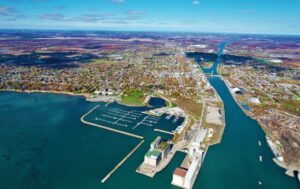Ontario to spend billions in COVID-19 recovery efforts
Ontario has revealed a $186.1 billion budget, with a projected deficit of $33.1 billion. This deficit has a predicted return to balanced budgets in 2029. $6.7 billion has been allocated to COVID-19 recovery, including $2.3 billion for testing and contact tracing, and $1 billion for public health units for vaccine efforts.
Hospitals and long-term care facilities have experienced incredible pressure during this pandemic and remain a central focus for spending. This has led to a further increase in healthcare spending with an additional $2.1 billion for hospitals and $650 million for long-term care facilities.
In order to support small businesses and families, a second round of cash grants ranging from $10,000 to $20,000 will be provided to small businesses in need of assistance due to expenses related to the pandemic. $260 million will go towards a new job training tax credit for 2021. $980 million will go to families with children, as they are offered a third round of payments through Ontario COVID-19 Child Benefit, increasing funds to $400 per child and $500 for each child with special needs. Also, a temporary $75 million, has been proposed for The Childcare Access and Relief from Expenses (CARE) tax credit for 2021, increasing support by around $250 per recipient.
$400 million will be allocated to the tourism sector over the next four years, and $50 million will go to faith-based and cultural organizations.
Region’s Planning Committee moves to give Niagara River environmental controls to unelected, unaccountable body
In a vote to be ratified by Regional Council today, the Niagara Region Planning Committee voted to support putting an unelected, self-appointed advocacy group in charge of the Niagara River.
If a “Ramsar” designation occurs, the advocacy group or Steering Committee becomes the Site Manager. Ramsar dictates that the Site Manager will create an ecological benchmark of the River and then create its own management plan aimed at maintaining the benchmark. Ramsar instructs that the “management plan is an essential document to guide all aspects of the site operation and administration.” It controls everything flowing into and out of the river. It requires its own on-going budget and even ‘Rangers’ to do monitoring.
The federal government’s Grant Hogg, who is Program lead for Environment Climate Change Canada, conceded in a letter that once the river has been ‘voluntarily designated’, “Site Managers (self-appointed Ramsar steering committee) are required to assure the maintenance of the ecological, hydrological, and socioeconomic characteristics and functions of the Site and promote the wise use of resources on this wetland area. Site managers are also responsible for communicating any human-induced changes on the site that affect ecological character to the Administrative Authority (Environment and Climate Change Canada).”
The Niagara Park Commission, the Niagara Falls Bridge Commission, the Town of Niagara-on-the-Lake and the City of Niagara Falls have all previously rejected the move. Three separate legal reports warned them against adoption of the Ramsar designation.
Welland approves reorganization of Corporate Leadership Team
At the City Council meeting on Tuesday night, the Welland City Council approved the reorganization of its Corporate Leadership Team effective immediately. The new Director of Infrastructure Services will be Sherri-Marie Millar. The Director of Planning and Development Services will be Grant Munday. Lina DeChellis will be the Manager of Economic Development and Rachelle Larocque the Manager of Planning Services.
Jo Zambito named Fire Chief for City of Niagara Falls
On March 23rd, Jo Zambito was named the Deputy Fire Chief at the Niagara Falls Fire Department. In 2016 he was hired as the City’s Deputy Fire Chief of Operations, and the Office of Fire Marshal and Emergency Management recently appointed Zambito as Alternate Fire Coordinator for the Niagara Region. It will be a smooth transition for Zambito to step into Fire Chief Jim Boutiliers role, who will be retiring after 31 years of service.
25 years ago Zambito began his career in Fire Services as Deputy Fire Chief at the Town of Niagara-on-the-Lake, and prior to that he worked as a Building Inspector and Municipal Enforcement Officer for the Town. His experience and commitment will be extremely complementary to the Senior Management Team, and the Department will continue to meet demands and thrive with Zambito’s leadership.
Fort Erie issues fire ban until further notice
Until further notice, Fort Erie has suspended all open-air burning permits and issued a burn ban. The dry, warm weather conditions have increased the risk of grass and brush fires, as the Fort Erie Fire Department has already responded to five grass fires. These fires occurred over the span of the weekend, and required about 130,000 litres of water, 700 hours of responder time, and equipment was damaged.
These fires put the entire town at risk, as they use a great deal of resources, and lead to the inability of firefighters to respond to other emergencies. This ban will be in place until further notice.
Earth Hour turns Niagara Falls sky dark this Saturday
This Saturday Niagara Falls will be going dark for Earth Hour. Other than streetlights and other essential safety lighting, all non-essential lighting throughout the city and its facilities, including the Niagara Falls nightly illumination, will be shut off from 8:30-9:30 p.m.
The Park in the City committee and the Niagara Falls Illumination Board are local supporters of the initiative. All businesses and residents are urged to turn off their lights and participate in Earth Hour.
French no longer offered to grades 1-3 in Niagara Catholic Board
While the Niagara Catholic Board has offered French classes for students in grades 1-3 for several years, starting September 2021, French classes will return to being offered beginning in grade 4. The shortage of qualified French teachers has forced the Niagara Catholic Board to make this decision.
Core French is required and fully funded by the Ministry of Education in Ontario starting in grade 4. While this difficult decision is unfortunate, it allows for a greater focus on French Immersion programs from grades 4-8, with stronger qualified teachers, as well as the ability to clear waiting lists. It will also give the students more time to focus on other subjects such as Health and Physical Education, and Science and Technology.
Niagara post-secondary institutions to receive $14.7 million in financial assistance from Ford government
Due to COVID-19, Niagara College and Brock University will be receiving an extra $14.7 million collectively from the Ford Government. Niagara College will receive $6.8 million, while Brock University will receive $7.9 million.
The province committed $106.5 million for post-secondary schools in Ontario in order to offset costs related to the COVID-19 pandemic, such as those associated with remote learning, personal protective equipment (PPE) and other expenses related to student financial support and human resources.
These investments allow advancements in academic and research plans, as well as developing services and programs delayed or altered by this pandemic. It also will enhance the support the schools can provide for their students and the community.
Opening of St. Lawrence Seaway beneficial for economic recovery
The St. Lawrence Seaway Management Corporation (SLSMC) welcomed marine traffic on March 22nd for its 63rd navigation season. The Seaway and carriers instilled strict COVID-19 protocols early in the pandemic, which lead to smooth service throughout, with about 38 million tonnes of cargo transited in 2020, which was quite comparable to the year prior.
Over the decades, the St. Lawrence Seaway has proved to be an economic success in Canada, creating thousands of middle-class jobs, and generating more than $9 billion in Canadian economic activity.
Vaccine rollout continues with updated plan
More than 57,000 individuals have now received COVID-19 vaccinations in the Niagara Region. Of these individuals, 8,100 have received their second dose, including 2,700 long-term care residents and 1,500 long-term care workers.
Niagara has received 65,715 doses of the Pfizer vaccine and 2,800 of Moderna. The region has yet to receive any AstraZeneca vaccines.
The province has updated the Region’s rollout plan, as Niagara is to receive 5,000 doses of the Moderna vaccine this week, and 16,380 doses of the Pfizer vaccine next week.
COVID-19 zone restrictions altered
On March 20th, restaurants in Niagara were allowed to start serving more people indoors. While the indoor capacity in the red-zone was 10 people, it has now been increased to 50% capacity, with up to 50 patrons. The orange-zone now allows 100 people indoors for events, up from 50.
Premier Doug Ford announced zone restriction alterations in order to support economic recovery. While less restrictive measures and adjustments to dining capacity have been put into place, individuals dining together must be from the same dwelling, with the exception of those living alone and caregivers. A third wave is also among us, with rates of variants continuing to rise, therefore it is imperative patrons remain cautious and vigilant to minimize COVID-19 transmission.
Canada-US Border – no reopening plan in sight
It has now been over a year since the Canada-US Border closed to non-essential travel in an attempt to control the spread of COVID-19. While Conservatives and US lawmakers in border States are pushing for restrictions to be lifted, Prime Minister Justin Trudeau has made it clear that Canada is not prepared to reopen as COVID-19 continues.
While other countries have released economic reopening plans, Prime Minister Justin Trudeau has failed to inform Canadians on what the future holds regarding economic activity and social life. There has been a lack of preparation for sector-specific support, rapid testing, timely vaccination procurement and delivery, and economic recovery measures.
The United States is projected to have every U.S. adult vaccinated, who wishes to be vaccinated, by the end of May. Canada has been less successful in both vaccine procurement and distribution.
The Niagara Region has been devastated by the impact COVID-19 has had on the travel and tourism industry. While the Region is reliant on tourism, cross-border travel will not return until the majority of the population has been vaccinated in both Canada and the United States according to the federal government.
COVID-19 Weekly Update
In the Niagara Region, as of March 24th, there are 53 new COVID-19 cases, 21 new resolved cases, and a total of 380 active cases. There have been 244 total variant cases, with 7 confirmed UK variant cases.
St. Catharines continues to have the most active cases with 82. Niagara Falls and Welland follow with 78 and 61 cases, respectively. Port Colborne and Wainfleet have the least active cases with 7 and 3, respectively.
There are 19 active outbreaks, two being in long-term-care homes, Albright Manor in Lincoln and Port Village in Port Colborne, and the outbreak at the Quaker Road school in Welland now has 15 confirmed cases.





















